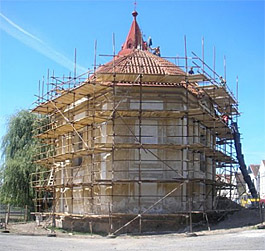
Rare Santini Chapel near Stříbro is undergoing a complete reconstruction
 |
"After removing the overpaintings that degraded the original painting, it is clear that the painting is of higher quality than it seemed," she stated. The frescoes, painted on dry plaster, likely date back to the time of the building's inception.
According to professor and architectural historian Milan Pavlík, the chapel was created by Jan Blažej Santini three years before his death, in 1720. "The building with a three-part layout was dedicated to St. Wenceslas by the abbot of the Kladruby monastery, Finzgut," he told ČTK. The abbots of the time were educated people and Finzgut chose Santini, who was already famous for many outstanding buildings. "The model was Panenské Břežany or a unique building with an extraordinarily complex interior space," the historian added.
However, the original chapel looked different than it does today, featuring two side entrances and lacking the current tower. A portion of the tower was built later to provide space for the sacristy and an internal staircase, with an oratory containing an organ on the upper floor. "In the 19th century, the tower was further extended," added Pavlík.
During reconstruction, restorers managed to uncover frescoes in three fields, the first features a motif of hope and faith, the second depicts Adam and Eve in paradise, and the third, the most damaged, shows the instruments of Christ's passion. The valuable painting is primarily damaged in the upper part of the vault, where water has leaked in. "Where there are large missing parts of the painting, reconstruction cannot be done. Therefore, there will be fillings in a neutral tone, and local defects can be retouched," Pavlíková said. According to her, the object is a gem at the regional level.
Valuable paintings also adorn the altar. "Here, we have already removed the overpaintings, and the sculptors are working on the stucco decoration. The magnificent relief of the dying Benedict was in very poor condition; moisture had damaged the stuccoes," the restorer added. In addition to the interiors, work is also being done on the reconstruction of the external shell of the building; the roof has already been repaired. "The flooring, which probably dates back to the First Republic, has also been removed. While it was of good quality, it was concrete and was causing moisture issues for the building," architect Jitka Pohořalá stated.
The chapel, which is owned by the municipality, is now regaining its original appearance. It is being successfully saved thanks to an eight million crown grant from Norwegian funds.
The English translation is powered by AI tool. Switch to Czech to view the original text source.
0 comments
add comment







